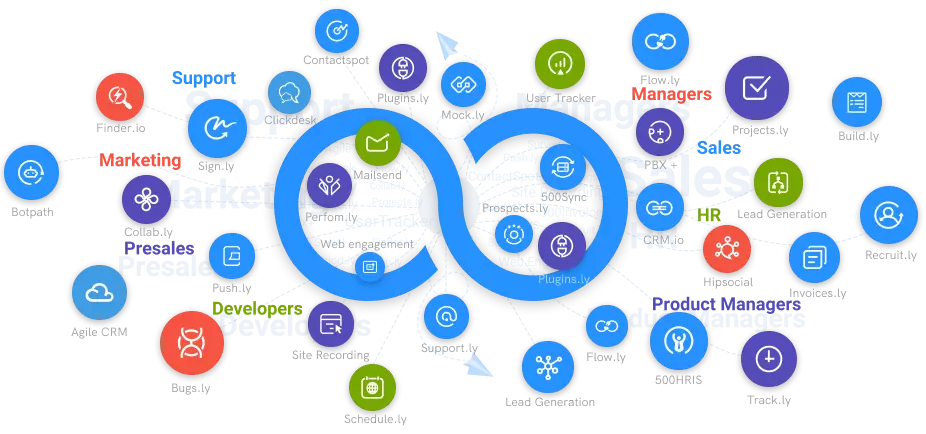What is BPMN?
Business Process Modeling Notation (BPMN) is a graphical language that can be used to represent business processes in a business process model. The notation can also be executed against to produce an executable process that adheres to the rules of BPM
#1
Unlimited Process Automation
#2
No-code Process Modelling
#3
Notifications and Triggers
#4
Auto Execute Capability
#5
Integrate with over 8 Apps Including Gmail
#6
Effective Form Designer
#7
Pre-built Automated Flows
#8
Intuitive, Drag-and-Drop Process Designer
#9
Unbelievable pricing - the lowest you will ever find
#10
Everything your business needs - 50 apps, 24/5 support and 99.95% uptime
What is BPMN?
BPMN stands for Business Process Modeling Notation, which is a flowchart approach for modeling the steps of a planned business process from start to finish. It is an important part of Business Process Management because it visually illustrates the sequence of business activities and information flows required to complete a process.
Its goal is to simulate approaches to increase efficiency, account for new situations, or obtain a competitive advantage for individual business process automation. In recent years, the approach has undergone a standardization drive, and it is now known by a somewhat different name: Business Process Model and Notation, still abbreviated as BPMN. It's not the same as the software design language Unified Modeling Language (UML).
Purpose and Benefits
At its most basic level, BPMN is designed to help participants and other stakeholders in a business process comprehend the steps through an easy-to-understand visual depiction. At a deeper level, it's aimed at the people who will carry out the process, providing enough detail to ensure flawless execution. It establishes a consistent language for all stakeholders, technical and non-technical, including business analysts, process participants, managers, and technical developers, as well as external teams and consultants. It should, in theory, bridge the gap between process intent and implementation by giving enough depth and clarity into the sequence of business activities.
The diagramming might be much easier to comprehend than narrative text. It facilitates communication and collaboration in order to achieve the goal of an efficient process that yields a high-quality outcome. It also aids communication, resulting in XML (Extensible Markup Language) documents that are required to complete various tasks. BPEL or BEPEL4WS, which stands for Business Process Execution Language for Web Services, is one of the most important XML standards.
BPMN depicts these four element types for business process diagrams:
Flow objects: events, activities, gateways Connecting objects: sequence flow, message flow, association Swimlanes: pool or lane Artifacts: data object, group, annotation
These are the individual elements and how they are used to define a business process:
1. Events
A trigger is a command that initiates, changes, or ends a process. A message, timer, error, compensation, signal, cancel, escalation, link, and more event types exist. They're represented by circles with various symbols based on the sort of event. Depending on their function, they are classed as "throwing" or "catching."
2. Activity
A person or a machine performs a specific activity or task. A rectangle with rounded corners represents it. They are capable of expanding with sub-processes, loops, compensations, and multiple instances.
3. Gateway
A decision point that allows the path to be adjusted based on conditions or events. They're depicted as diamonds and can be exclusive, inclusive, parallel, or complex. Data-driven and event-driven options are available (and in many cases, both), meaning that the user is not limited to one or the other.
4. Sequence Flow
This arrow indicates the order in which the actions are to be completed. In some cases, a conditional or default flow will be displayed. A flowchart is a type of chart that organizes and conveys the steps in a process, workflow, algorithm, or operation. Flowcharts are often used for depicting processes within business and manufacturing with various symbols representing different operations.
5. Message Flow
Messages that flow across "pools," or organizational barriers like departments, are depicted. It should not be used to connect events or activities that take place within a pool. A dashed line with a circle at the start and an arrow at the end is used to depict it.
6. Pool and Swimlane
A pool represents the most important players in a process. Although a different pool may be in a different organization or department, it is still a part of the process. Within a pool, swimlanes depict the activities and flow for a specific role or participant, indicating who is responsible for which aspects of the process.
7. Artifact
Developers add extra information to the diagram to provide the desired amount of depth. Data objects, groups, and annotations are the three categories of artifacts. A data object depicts the data that is required for a specific action. A group depicts a reasonable grouping of activities without altering the flow of the graphic. Annotation adds to the understanding of a component of the diagram.
Lucidchart makes creating business process models simple. Simply log in after joining up, then start with a blank document or a template. Make sure the BPMN forms library is open before dragging and dropping shapes into the canvas.
To achieve the desired style, you can also stylize lines, format text, and move items. After that, you can share, download, or export your diagram in any way you like.





